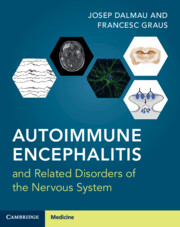Book contents
- Autoimmune Encephalitis and Related Disorders of the Nervous System
- Autoimmune Encephalitis and Related Disorders of the Nervous System
- Copyright page
- Dedication
- Contents
- Clinical Vignettes
- Videos
- Preface
- Abbreviations
- Section 1 Overview
- Section 2 Antibodies and Antigens
- Section 3 Specific Syndromes and Diseases
- Section 4 Autoimmunity in Neurological and Psychiatric Diseases
- Chapter 19 Autoimmune Psychosis
- Chapter 20 Psychiatric Manifestations of Autoimmune Encephalitis
- Chapter 21 Abnormal Movements in Neurological Autoimmune Disorders
- Chapter 22 Sleep and Autoimmunity
- Chapter 23 Immunity, Inflammation, and Epilepsy
- Chapter 24 Autoimmune Dementia: A Useful Term?
- Chapter 25 Frequently Asked Questions on Autoimmune Encephalitis and Related Disorders
- Index
- References
Chapter 24 - Autoimmune Dementia: A Useful Term?
from Section 4 - Autoimmunity in Neurological and Psychiatric Diseases
Published online by Cambridge University Press: 27 January 2022
- Autoimmune Encephalitis and Related Disorders of the Nervous System
- Autoimmune Encephalitis and Related Disorders of the Nervous System
- Copyright page
- Dedication
- Contents
- Clinical Vignettes
- Videos
- Preface
- Abbreviations
- Section 1 Overview
- Section 2 Antibodies and Antigens
- Section 3 Specific Syndromes and Diseases
- Section 4 Autoimmunity in Neurological and Psychiatric Diseases
- Chapter 19 Autoimmune Psychosis
- Chapter 20 Psychiatric Manifestations of Autoimmune Encephalitis
- Chapter 21 Abnormal Movements in Neurological Autoimmune Disorders
- Chapter 22 Sleep and Autoimmunity
- Chapter 23 Immunity, Inflammation, and Epilepsy
- Chapter 24 Autoimmune Dementia: A Useful Term?
- Chapter 25 Frequently Asked Questions on Autoimmune Encephalitis and Related Disorders
- Index
- References
Summary
In this chapter we review the CNS syndromes mediated by autoimmune or inflammatory mechanisms in patients with cancer. Paraneoplastic neurological syndromes (PNS) are considered to be immune-mediated disorders against proteins expressed by the tumour and nervous system. The autoimmune hypothesis is supported by the presence in serum and CSF of antibodies against neural proteins that are also expressed in the tumour. Less frequently the tumour does not express neuronal proteins but predisposes to immune dysregulation and autoimmune mechanisms. Novel cancer therapies that enhance anti-tumour immune responses frequently cause inflammatory CNS disorders. Immune checkpoint inhibitors have been associated with a wide range of immune-related adverse effects, including an increased incidence of PNS. Another type of cancer therapy is based on the use of T cells genetically engineered to express chimeric antigen receptors (CARs) that recognize molecules present on the surface of tumour cells. CAR T cell therapy can cause severe, potentially lethal, encephalopathy syndromes mediated by massive release of cytokines instead of autoimmune mechanisms. Post-transplant autoimmune encephalitis are rare disorders that mostly occur after allogeneic haematopoietic stem cell transplantation. They are related to graft versus host disease and, sometimes, they associate with antibodies against neuronal surface antigens.
Keywords
- Type
- Chapter
- Information
- Publisher: Cambridge University PressPrint publication year: 2022



